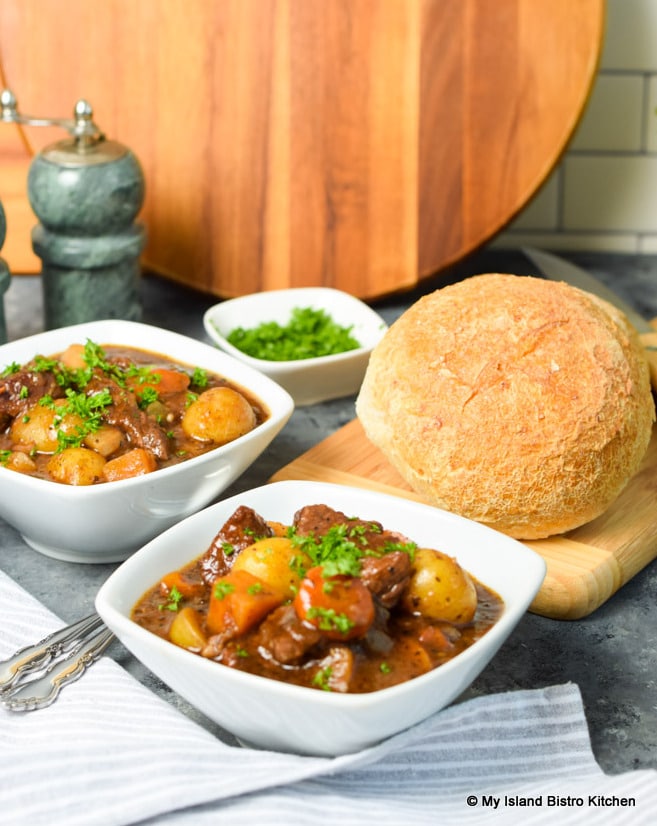
A hearty Beef Stew is a soul-satisfying and tummy-filling meal. It’s pure stick-to-the-ribs comfort food, especially on cool autumn or cold winter days. Made with basic ingredients, what makes this hearty Rustic Homestyle Beef Stew so wonderfully tasty (in addition to the Beef Seasoning Mix) is the long, slow, moist heat method of cooking a tougher cut of meat in a small amount of flavorful liquid to tenderize the meat. I believe this is what makes the difference between a bland, lacklustre beef stew and a super flavorful one.
The method of cooking I use for this stew is great to use for cuts of meat known to be on the tougher side because the combination of seasoning the meat, moist heat, low cooking temperature, lengthy cooking time, and a flavorful liquid breaks down the connective tissues (collagen) in the meat, melting it into a silky gelatin. This results in divinely tender and succulent meat that is almost melt-in-the-mouth quality. If you have ever had a beef stew where the meat is an ugly grayish color and tough as shoe leather, it’s likely that it was the wrong cut of beef used, the meat was not seasoned and seared, deglazing of the pan did not take place, and/or the meat was cooked in way too much liquid. This stew is not that kind of stew!
If you are a beef lover, this Rustic Homestyle Beef Stew is for you!
Choosing and Preparing the Beef
Cuts of beef suitable for stews are muscular meats like chuck, for example. These cuts from the highly exercised parts of the animal are ones known to have lots of collagen that, like magic, when cooked long and slow, turn tough cuts of meat into soft gelatin that will literally break apart with the touch of a fork.
I will often see, on supermarket meat shelves, packages of stew beef labeled as lean “deluxe” or “premium” stewing beef. Sure, they look bright red and, often, there is very little or nil marbling to be seen. In short, they “look” perfect. However, the lack of marbling comes at the cost of flavor, juiciness, and tenderness of the meat. Additionally, using more premium cuts of lean, perfect looking beef will not become more fork tender than the cheaper cuts in this stew so, save your money and buy the economical cuts.
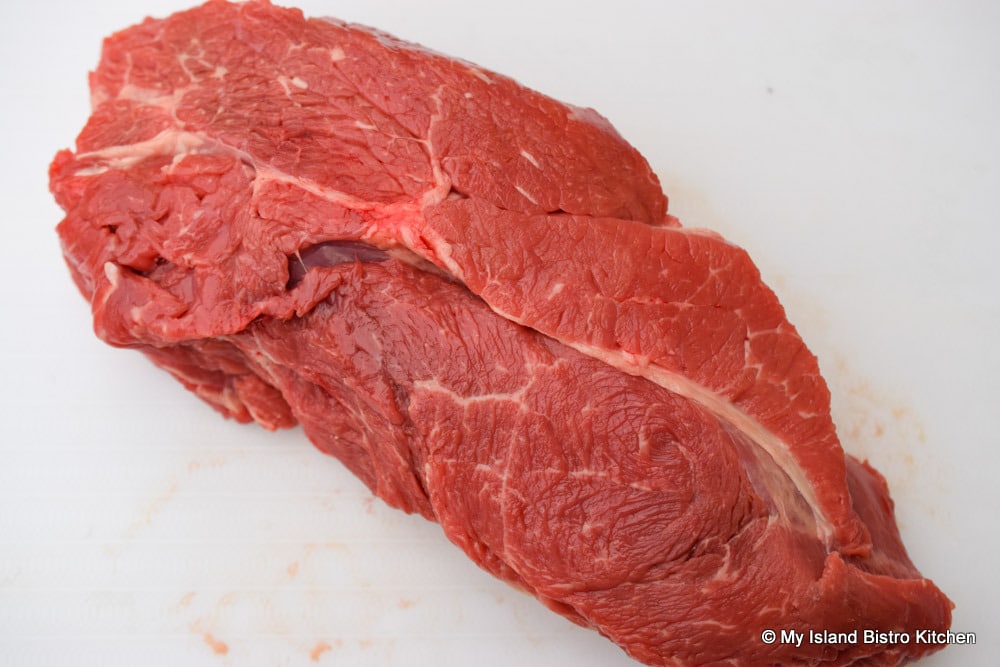
The first step, then, in making a tasty stew is to look for beef with marbling – the white streaks and specks of fat running through the meat that are fine and fairly uniformly distributed across the cut. Why? The slow cooking process for the stew will melt the fat and turn it into a melt-in-your-mouth gelatin. The transformation is absolutely amazing and the reward is tender, juicy meat with flavor! I like to go directly to my local butcher where I can examine both sides of the meat before it is packaged and buy exactly the meat I want in one piece (and not pre-cut chunks) and which I can take home and cut into the size of chunks I want for whatever it is I am making.
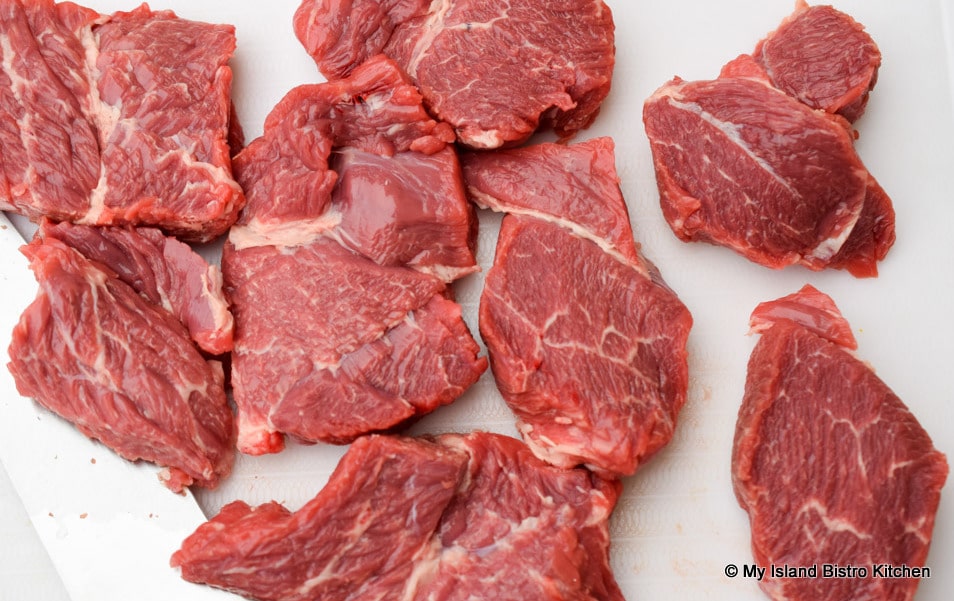
Remove the meat from the refrigerator about 30-40 minutes prior to making the stew. This will take the refrigerated chill off the beef and “temper” the meat so that it is not a case of ice-cold meat shocked by going into a very hot pan for searing. This will allow the seasoning mix to stick to the meat better and permit more evenly seared beef resulting in more juicy and tender beef chunks in the stew.
If there happens to be any excess hard fat, tendons, or silver skin still visible on the meat, remove and discard them. I like to cut my stew beef into chunks, about 1¼ “ – 1½“ pieces. This stew is meant to be a rustic dish and cutting the meat any smaller may cause the meat to dry out faster and it won’t have the same homestyle presentation as if the chunks are a bit larger.

Pat the meat (all sides) dry with paper towel – this will help the seasoning mix to stick to the meat when it is dredged before being seared.
Seasoning and Searing the Meat
I like to season the meat with my homemade seasoning mix (recipe below). When the beef chunks are dredged in this mixture and seared, it embeds flavor directly into the beef and what is left in the pan will be captured when the pan is deglazed with red wine following the searing process. I prefer to use cornstarch instead of flour as the stew thickener because I find it gives a brighter, clearer sauce to the stew than does flour and I add the cornstarch directly into the seasoning mix. With my method, the seasonings, salts, and thickener are all included in the one mix.
The easiest way I have found to dredge stew meat chunks is to place some of the seasoning mix in a plastic bag with a few chunks of the meat. Work in batches; don’t try to dredge all the meat chunks at once. Close the plastic bag and give the bag a good shake to ensure all sides of each chunk of beef are coated. Shake off the excess flour from each chunk. Repeat with the remaining beef. Once the meat is dredged in the seasoning mix, it’s time to sear it over medium-high heat in oil.
Searing the meat before adding it to the cooking liquid is known as brown braising. Don’t skip this step as it will add depth of savory flavor as the meat caramelizes while a brown crust forms on the beef. This ‘browning” will not only add flavor but it will help produce a rich brown sauce. Don’t try to speed up the process by over-crowding all the meat pieces into the pan at once. Work in batches and leave some space between the chunks of meat so they brown nicely. The aim of this process is to sear the meat until it reaches a lovely deep brown color, not steam it or cook it all the way through. About 45-60 seconds per side of the beef chunks the size called for in this recipe should suffice. Be sure to brown all sides. Start out with the skillet on medium-high heat. If you find, when you start searing the meat, that the heat is too high, reduce the temperature a bit. Just know that a reasonably high heat is needed to caramelize the meat.
If you have a Dutch oven or other casserole or pot that is both stovetop safe at high temperature as well as oven safe, this stew can all be entirely made in the same cooking vessel. However, if you have an enameled cast-iron Dutch oven, for example, be sure to check the instructions that came with it to confirm it can sustain being used over medium-high heat on the stovetop. Mine is not recommended for stovetop usage above the medium heat level so I sear the meat (which is done over medium-high heat) in either a stainless steel or cast-iron skillet and then transfer the seared meat to the Dutch oven for the remainder of the cooking process.
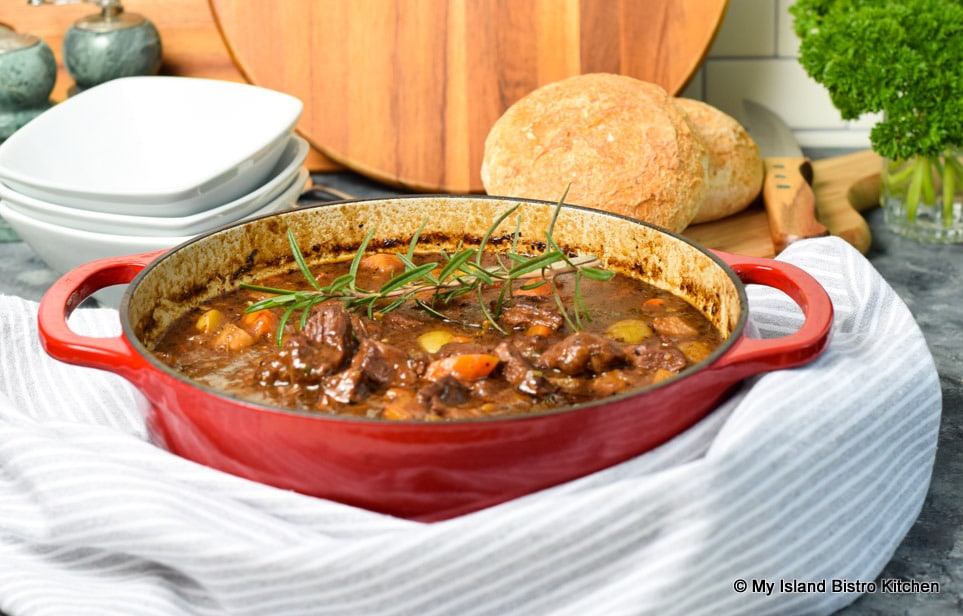
My Rustic Homestyle Beef Stew is actually more of a cross between a braise and a stew. With braising, the braising liquid should not entirely cover the meat. With a stew, on the other hand, the meat is usually completely covered with liquid. For this beef stew, I go somewhere in the middle, using a bit more than I do when braising but just enough liquid that the meat is barely, or almost, covered with liquid but no extra. That’s why I don’t add all the stock at once to this stew. I believe, if the meat is swimming in liquid, tough cuts of meat will not tenderize to the extent possible. In addition, adding too much liquid will dilute the sauce and flavor, especially if added too early in the cooking process.
Deglazing the Pan
Once the meat has been seared in oil, there will be caramelized brown bits (known as fond) left in the pan. This has wonderful flavor (remember, it will have some of the beef seasoning mix still in it) and will help to deepen the color of the stew. It’s time to deglaze the pan.
Remove the skillet from the heat and drain off any excess fat remaining. Reduce heat to medium-low. Add the red wine to the skillet off heat and then return it to the heat. Using a wooden spoon, scrape up all the flavorful brown bits. This deglazing of the pan produces a mixture that adds a layer of flavor complexity, richness, and depth to this stew. Alternatively, beef or poultry stock can be used for the deglazing. However, my preference is to use red wine as the acidic properties in the red wine not only add flavor to the dish but, importantly, soften muscle fibres and generate melt-in-your-mouth quality meat.
I recommend using a dry red wine for the deglazing. While technically any dry red wine will work in this stew, I like to use a Pinot Noir that has earthy notes to it – it tends to be a wine that goes well with all sorts of red meat. Slowly boiling the wine for 3-4 minutes will burn off the raw alcohol and reduce the wine to about half of its original amount. This dish is not meant to reek of the wine; rather, the role of the wine is, yes, partly to flavor the sauce in a good way but, more importantly, to tenderize the meat. There is no need to go with the best wine on the market for this stew but I do suggest using one you would be prepared to drink. This deglazed mixture will then be added to the mirepoix in the Dutch oven and will add wonderful flavor. Deglazing is not a step to be omitted if you are looking for a flavorful stew.
Mirepoix
Prepare the mirepoix (sautéed onion, celery, and carrot). I am following the traditional mirepoix ratio of 2:1:1 for this recipe. That is: 2 parts onion to one part each of celery and carrot. The vegetables need to be diced in uniform size for the mirepoix, in diced pieces about ¼” in size are suitable for this stew.
These simple, basic aromatics always form a good savory flavor base for any dish and stew is no exception. I use a combination of olive oil and butter for cooking the mirepoix over medium-low heat. Butter (which gives fabulous flavor) tends to burn easily which causes some flavor deterioration. Olive oil, however, does not burn so quickly so heating it first then adding the butter prevents the butter from burning and yet the dish still has some buttery flavor. Don’t brown or burn the vegetables. The goal is to sauté the vegetables to extract their flavor. They should be sautéed, in total, for 10-12 minutes, until the carrot and celery are somewhat softened and the onion transparent.
I add 4-5 minced garlic cloves to the mirepoix, briskly stirring them for approximately 20-30 seconds. Ensure the garlic does not scorch or burn.
The Sauce
Apart from tender, juicy beef, what makes a great beef stew is the sauce that surrounds the meat and veggies. I have created this recipe to have layers of flavor. The first layer starts with the beef seasoning mix followed by the deglazing process with red wine that picks up any remaining seasoning mix and brown bits from the beef left in the pan after the meat has been seared. Add a cup of passata (or about 1/3 cup of tomato paste mixed with a scant 2/3 cup of stock) to add a rich tomato base and more color to the sauce.
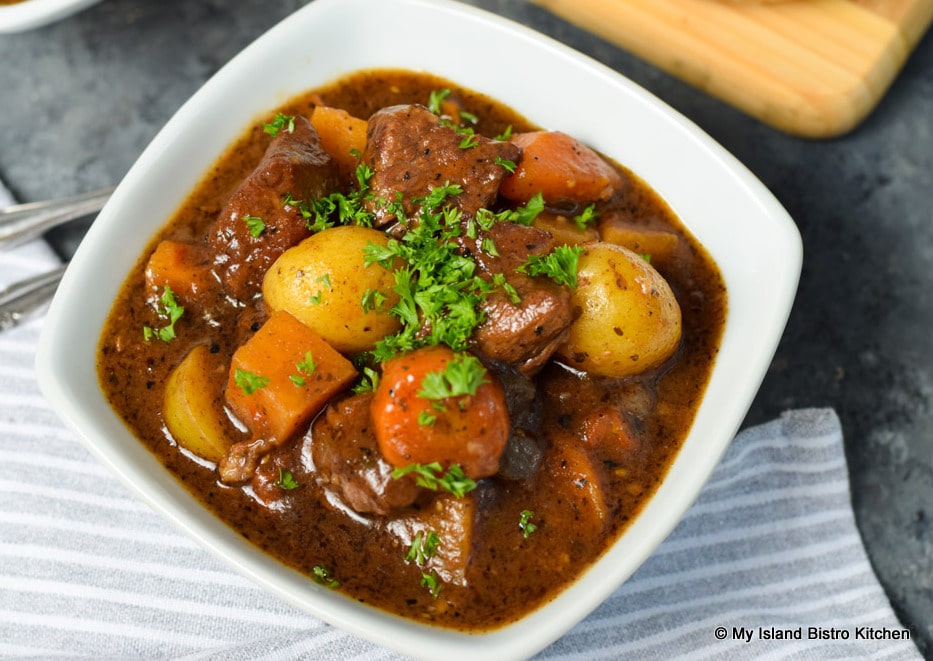
Use a good, rich beef or poultry stock. Either beef or poultry stock can be used in this stew (yes, it is perfectly fine to use a poultry stock with beef). Either homemade (click here for my beef stock recipe and here for my turkey stock recipe) or purchased stock can be used in this recipe. The better the quality of stock, the better the stew flavor.
Adding either beef or poultry stock (as opposed to only using water or wine as the cooking liquid), adds another layer of flavor. Adding only water will result in a stew lacking flavor and, in my opinion, using only wine would make the resulting sauce too strong. The hallmark of a well-prepared stew is the subtle layers of flavors that build the overall deep savory flavor profile. Because the seasoning mix I use for dredging the beef contains significant herbs and spices, I don’t add a lot of extra seasoning to the stew itself – only some Worcestershire sauce, a small amount of Herbes de Provence, a bay leaf, a couple of sprigs of fresh thyme, and a tablespoon of brown sugar for flavor balance. The long, slow cooking of the stew allows these flavors to mix and mingle resulting in a flavorful stew.
How thick the sauce of this stew should be is really a matter of personal preference. The seasoning mix does contain the thickening agent, cornstarch, which should thicken the stew nicely. However, if a slightly thicker stew is desired, 2 teaspoons of cornstarch can be whisked with some stock or water to make a “slurry”, tempered with some hot stew liquid, and the slurry stirred into the stew in its later stages of cooking – i.e., during the last 10-15 minutes of cooking. As a word of caution, though, cornstarch will thicken a stew quite quickly to the point of it becoming super thick with an almost pasty texture so only start with a small amount of cornstarch (i.e., 2 teaspoons) and let that cook in the stew for a few minutes before, if necessary, adding any additional slurry. The stew will continue to thicken somewhat after it comes out of the oven and starts to cool a bit to eating temperature before serving. The sauce should have some fluidity to it and it should not be a thick paste texture. As a general rule of thumb, or frame of reference, the sauce should be, at a minimum, thick enough to coat the back of a spoon well. It should not be a thin, watery broth consistency.
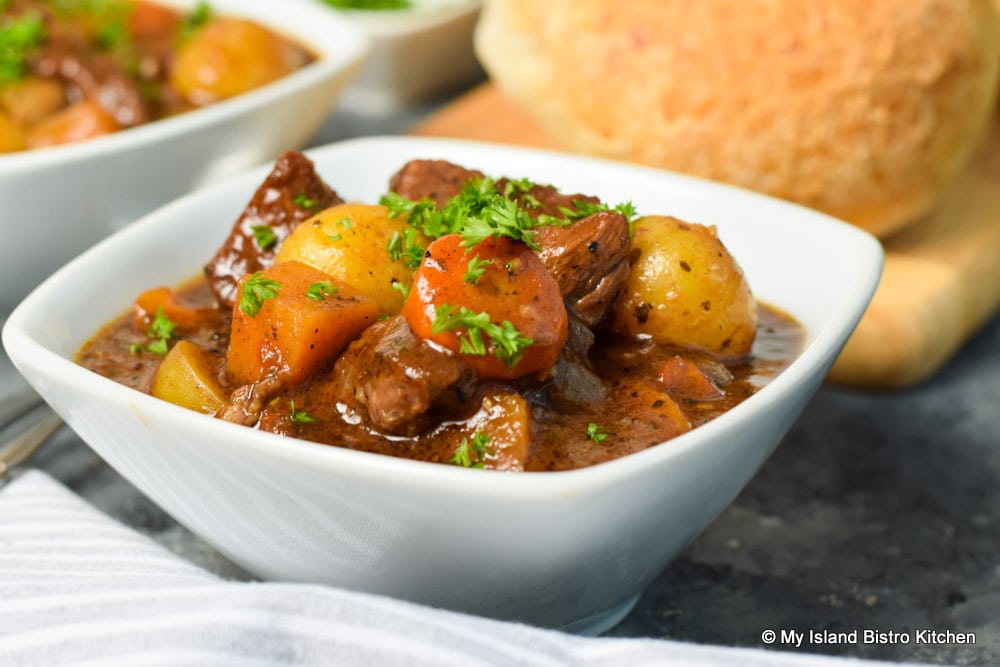
It’s important to keep the Dutch oven covered tightly once the stew goes into the oven as this will keep the moist heat in. Otherwise, the liquid will evaporate and the meat may be subject to some drying out. Dutch ovens are often used for braising and stew making because they have the width for the contents to evenly cook and they have tight fitting covers. The important thing is to use a cooking vessel (with a tight-fitting cover) that allows the sauce to surround the meat for this recipe.
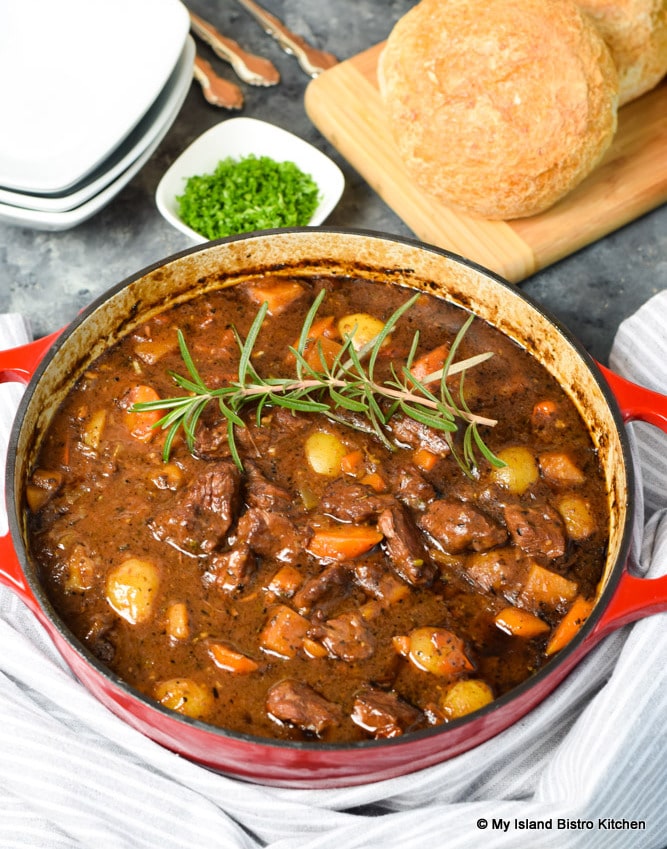
Some stews are cooked entirely on the stovetop. My preference, however, is to slowly cook the stew in slow heat in the oven which gives a more even temperature all around the Dutch oven. This is in contrast of cooking stew on the stovetop where the majority of the heat will be concentrated on the bottom of the Dutch oven.
Vegetables
This recipe calls for very simple, basic vegetables (the kind I would refer to as humble vegetables) – parsnips (always a flavor booster in soups and stews), rutabaga (turnip), carrots, and potatoes. If you like an all-in-one stew, add diced potatoes or, if desired, petite mini potatoes — either whole or cut in half, depending on their size. The baby petite yellow potatoes in the photo below were grown by W.P. Griffin of Elmsdale, PEI, and these potatoes were tiny enough to be left whole for the stew.
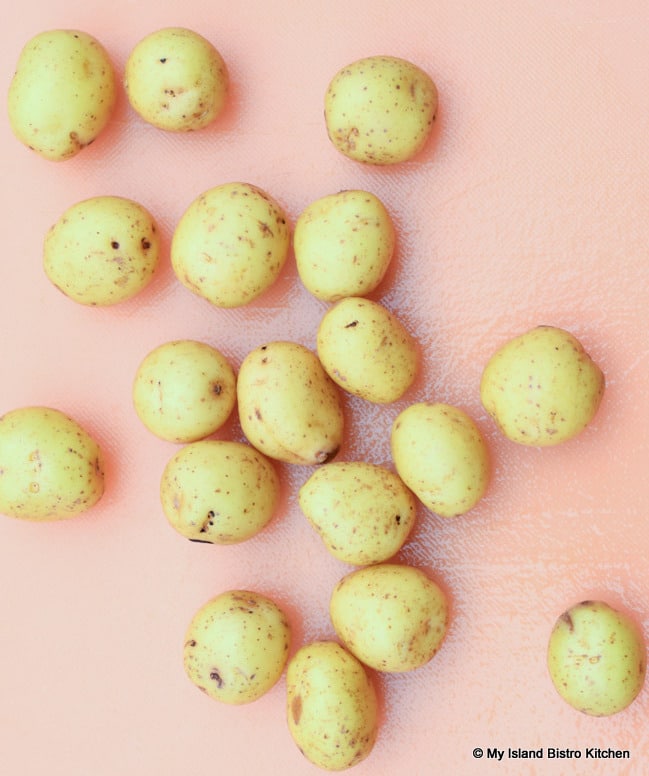
Use waxy potatoes like Yukon Gold or a red potato variety for this stew as these hold up and retain their shape for the long cooking period. This is in contrast to a more starchy and grainy variety of potato (e.g., Russet) that tends to break down and become mushy during long cooking periods as is the case with stews. If you prefer to serve the stew over mashed potatoes or hot buttery noodles, omit the 8 oz of potato called for in the recipe altogether and replace the 8 oz of potato with the same amount of a mix of additional carrot, turnip, and parsnip.
I like to add some grape or cherry tomatoes to this stew as they burst and impart great flavor and additional color to the stew sauce. We grow a lot of grape and/or cherry tomatoes every year in the garden. They are prolific producers and I don’t like to waste food so I freeze bags of them and toss them into soups and stews over the fall and winter. Fresh tomatoes can, of course, be used but so can frozen ones.
Different vegetables require different cooking times. Root vegetables are notorious for taking a long time to cook, especially in stews cooked at lower temperatures. So, when the seared beef and sauce first go into the oven, include the parsnip and turnip as they take the longest to cook. About 45 minutes later, add the carrots (and reduce the oven temperature to 275°F) and, about 40 minutes after that, add the potatoes that take the least amount of time to cook. If desired, some frozen peas can be added to the last 10 minutes of cooking.
The method used to cook this wonderful stew is, in my view, as important as the ingredients that go into it. For that reason, I do not recommend alternative cooking methods for making this particular stew. It takes a bit of time to sear the meat, deglaze the pan, sauté the mirepoix, and chop the vegetables but, once the stew is in the oven, it’s pretty much doing its own thing and doesn’t require a lot of supervision. The reward for investing the time is a super tasty and savory Beef Stew! As a hint, I think this stew actually tastes even better the next day after its flavors have had a chance to mix, mingle, and deepen!
Rustic Homestyle Beef Stew
Ingredients:
1½ lb beef chuck roast (with good marbling), trimmed of excess fat and any silver skin, cut into 1¼ “ – 1½“ chunks
Beef seasoning mix (recipe below)
3 – 4 tbsp olive oil
2 tbsp olive oil
1 tbsp butter
½ cup onion, diced into ¼“ pieces
¼ cup celery, diced into ¼“ pieces
¼ cup carrot, diced into ¼“ pieces
4 – 5 garlic cloves, minced
¾ cup dry red wine
1 cup passata (or 1/3 cup tomato paste mixed with a scant 2/3 cup beef or poultry stock)
1½ cups beef or poultry stock (reserve ½ cup for later adding to stew)
1 tbsp Worcestershire sauce
1 tbsp brown sugar
1 teaspoon Herbes de Provence
2 sprigs fresh thyme
1 bay leaf
3 oz parsnip, cut into ½“ chunks
5 oz rutabaga (aka turnip), cut into ½“ chunks
5 oz carrots, sliced into ½“ chunks (or 5 oz petite baby carrots)
5 oz grape or cherry tomatoes
8 oz waxy potatoes (*See Note 1 below) (e.g., Yukon gold, red potatoes), cut into 1” – 1¼“ chunks (or use petite mini potatoes whole or halved, depending on their size)
Fine sea salt and freshly cracked pepper, to taste
½ cup frozen peas (optional)
½ tbsp chopped fresh parsley or sprigs of rosemary (optional for garnish)
Optional:
2 tsp cornstarch
1½ tbsp beef or poultry stock
Method:
Dice the onion, celery, and carrot. Mince the garlic. Set aside.
Bring beef to room temperature for approximately 30-40 minutes. Trim off any large pieces of excess fat as well as any silver skin that may still be on the beef. Cut beef into 1¼” – 1½“ chunks. Pat beef dry with paper towel.
Position oven rack in lower third of oven and preheat oven to 300°F.
Heat 1½ – 2 tablespoons of olive oil in stainless steel or cast-iron skillet over medium-high heat.
Place approximately 2 tablespoons of the beef stew seasoning mix (recipe below) in a plastic bag. Working in batches, place a few chunks of meat at a time in the bag with the seasoning mix. Close the plastic bag and shake the bag until all sides of the beef chunks are coated. Shake off excess seasoning mix from each piece of meat. Transfer dredged beef to the hot skillet, leaving space between each chunk. Do not crowd meat in the skillet. Sear the meat. Using tongs, turn the meat to brown the beef on all sides, about 45 – 60 seconds per side. Transfer seared meat to a plate. Repeat with remaining beef chunks, adding more seasoning mix as needed to the bag as well as more oil to the skillet, if required.
Pour off any excess fat remaining in the skillet. Reduce heat to medium-low. Remove the skillet from the heat and slowly add the red wine and stir. Return the skillet to the heat and, using a wooden spoon, scrape up any of the caramelized brown bits remaining and stuck to the bottom of the skillet after the meat was seared. Slowly boil the wine gently for 3-4 minutes to burn off the raw alcohol. Once all the brown bits have been loosened and mixed in with the wine and the liquid has reduced to almost half its original amount, remove the skillet from the heat and set aside.
While the skillet mixture is deglazing, heat 2 tablespoons of oil in a 3-quart Dutch oven or other stovetop and ovenproof pot or pan over medium low heat and then add the tablespoon of butter. When the butter has melted, add the carrot and celery and cook for approximately 3-4 minutes then add the onion. Cook, stirring frequently, for 6-8 minutes, until the carrot and celery are slightly softened and the onion has become transparent. Add the minced garlic and, stirring quickly, sauté it for about 20-30 seconds. Do not let the garlic scorch.
Using a rubber or silicone spatula, scrape out the deglazed pan and transfer the reduced wine mixture into the Dutch oven with the mirepoix (sautéed carrot, celery, and onion).
Add the passata (or tomato paste mixture), 1 cup of the poultry or beef stock, Worcestershire sauce, brown sugar, and Herbes de Provence to the Dutch oven. Cook over medium low heat just until the liquid starts to boil. Add the seared beef, parsnip, rutabaga (aka turnip), sprigs of thyme, and bay leaf. Cover Dutch oven and transfer to pre-heated oven for about 45 minutes then stir gently and add the carrots. Reduce the heat to 275°F. and cook the stew for 40 minutes longer. Stir stew and add the potatoes, tomatoes, and remaining half cup of stock along with some fine sea salt and freshly cracked pepper, to taste. Continue cooking the stew until all the vegetables are fork tender, about 45-50 minutes.
If a thicker sauce is desired, whisk 2 teaspoons cornstarch with 1½ tablespoons of stock or water to make a “slurry”. Add some hot stew liquid to temper the slurry and stir into the stew. Cook for 10-15 minutes longer. If desired, add the frozen peas during the last 10 minutes of cooking.
Discard bay leaf and thyme sprigs. Ladle stew into bowls and garnish with fresh chopped parsley and/or a sprig of fresh rosemary, if desired.
Yield: Apx. 6 servings
Beef Seasoning Mix
¼ cup cornstarch
½ tbsp paprika
½ tbsp dried basil
½ tbsp dried parsley
1 tsp dried oregano
½ tsp dried thyme
½ tsp crushed rosemary
½ tsp garlic salt
½ tsp onion powder
¼ tsp celery salt
¼ tsp marjoram
1/8 tsp ground fennel
1/16 tsp cayenne
½ tsp fine sea salt
1/16 tsp freshly ground pepper
Mix ingredients together. Store in tightly covered container until needed.
Recipe Notes:
1) If you like an all-in-one stew, add diced potatoes or, if desired, petite mini potatoes either whole or cut in half (depending on their size). Use waxy potatoes like Yukon Gold or a red potato variety as these hold up and retain their shape. This is in contrast to a more starchy and grainy variety of potato (e.g., Russet) that tends to break down and become mushy during long cooking periods as is the case with stews.
2) If you prefer to serve the stew over mashed potatoes or hot buttery noodles, omit the 8 oz of potato called for in the recipe altogether and replace the 8 oz of potato with the same amount of a mix of additional carrot, rutabaga (turnip), and parsnip.
3) If you have a Dutch oven or other casserole or pot that is both stovetop safe at high temperature and oven safe, this stew can entirely be made in the same cooking vessel – i.e., the meat can be seared, the mirepoix sautéed, and the pan deglazed all on the stovetop and then the stew placed in the oven. However, if you have an enameled cast-iron Dutch oven, be sure to check the instructions that came with it to confirm it can sustain being used over medium-high heat on the stovetop. If it cannot safely be used over medium-high heat, it is recommended to sear the meat (which is done over medium-high heat) in a stainless steel or cast-iron skillet and then transfer the seared meat to the Dutch oven for the remainder of the cooking process.
4) The seasoning mix contains the thickening agent, cornstarch, which should thicken the stew nicely. However, if a slightly thicker stew is desired, 2 teaspoons of cornstarch can be whisked with about 1½ tablespoon of stock or water to make a “slurry”, then tempered with some hot stew liquid, and the slurry stirred into the stew in its later stages of cooking. As a word of caution, though, cornstarch will thicken a stew quite quickly to the point of it becoming pasty so only start with a small amount of cornstarch (i.e., 2 teaspoons) and let that cook in the stew for a few minutes before, if necessary, considering the addition of any further thickener.
If you have made this recipe and enjoyed it and/or wish to share it with your friends, please do so on social media and share the direct link to the Rustic Homestyle Beef Stew recipe on my website.
Connect with My Island Bistro Kitchen on Social Media
Join the Facebook page for My Island Bistro Kitchen: https://www.facebook.com/MyIslandBistroKitchen/
Follow “the Bistro” on “X” (formerly Twitter): https://twitter.com/PEIBistro/
See the drool-worthy gallery of mouth-watering food photos from My Island Bistro Kitchen on Instagram: https://www.instagram.com/peibistro/
Follow “the Bistro” on Pinterest at https://www.pinterest.ca/peibistro/ and pin the Pinterest-ready photo at the end of this posting to your favorite Pinterest boards!
PIN ME TO PINTEREST!
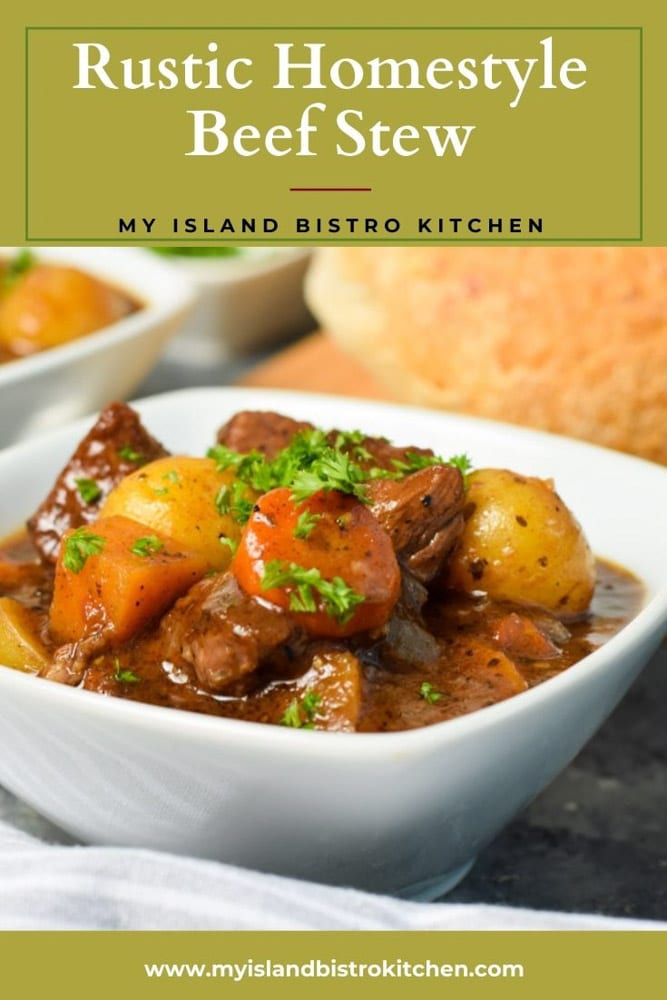
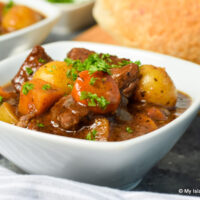
Rustic Homestyle Beef Stew
Ingredients
- 1½ lb beef chuck roast (with good marbling), trimmed of excess fat and any silver skin, cut into 1¼ “ – 1½“ chunks
- Beef seasoning mix (recipe below)
- 3 - 4 tbsp olive oil
- 2 tbsp olive oil
- 1 tbsp butter
- ½ cup onion, diced into ¼“ pieces
- ¼ cup celery, diced into ¼“ pieces
- ¼ cup carrot, diced into ¼“ pieces
- 4 - 5 garlic cloves, minced
- ¾ cup dry red wine
- 1 cup passata (or 1/3 cup tomato paste mixed with a scant 2/3 cup beef or poultry stock)
- 1½ cups beef or poultry stock (reserve ½ cup for later adding to stew)
- 1 tbsp Worcestershire sauce
- 1 tbsp brown sugar
- 1 teaspoon Herbes de Provence
- 2 sprigs fresh thyme
- 1 bay leaf
- 3 oz parsnip, cut into ½“ chunks
- 5 oz rutabaga (aka turnip), cut into ½“ chunks
- 5 oz carrots, sliced into ½“ chunks (or 5 oz petite baby carrots)
- 5 oz grape or cherry tomatoes
- 8 oz waxy potatoes (*See Note 1 below) (e.g., Yukon gold, red potatoes), cut into 1” – 1¼“ chunks (or use petite mini potatoes whole or halved, depending on their size)
- Fine sea salt and freshly cracked pepper, to taste
- ½ cup frozen peas (optional)
- ½ tbsp chopped fresh parsley or sprigs of rosemary (optional for garnish)
- Optional:
- 2 tsp cornstarch
- 1½ tbsp beef or poultry stock
Instructions
- Dice the onion, celery, and carrot. Mince the garlic. Set aside.
- Bring beef to room temperature for approximately 30-40 minutes. Trim off any large pieces of excess fat as well as any silver skin that may still be on the beef. Cut beef into 1¼” - 1½“ chunks. Pat beef dry with paper towel.
- Position oven rack in lower third of oven and preheat oven to 300°F.
- Heat 1½ - 2 tablespoons of olive oil in stainless steel or cast-iron skillet over medium-high heat.
- Place approximately 2 tablespoons of the beef stew seasoning mix (recipe below) in a plastic bag. Working in batches, place a few chunks of meat at a time in the bag with the seasoning mix. Close the plastic bag and shake the bag until all sides of the beef chunks are coated. Shake off excess seasoning mix from each piece of meat. Transfer dredged beef to the hot skillet, leaving space between each chunk. Do not crowd meat in the skillet. Sear the meat. Using tongs, turn the meat to brown the beef on all sides, about 45 – 60 seconds per side. Transfer seared meat to a plate. Repeat with remaining beef chunks, adding more seasoning mix as needed to the bag as well as more oil to the skillet, if required.
- Pour off any excess fat remaining in the skillet. Reduce heat to medium-low. Remove the skillet from the heat and slowly add the red wine and stir. Return the skillet to the heat and, using a wooden spoon, scrape up any of the caramelized brown bits remaining and stuck to the bottom of the skillet after the meat was seared. Slowly boil the wine gently for 3-4 minutes to burn off the raw alcohol. Once all the brown bits have been loosened and mixed in with the wine and the liquid has reduced to almost half its original amount, remove the skillet from the heat and set aside.
- While the skillet mixture is deglazing, heat 2 tablespoons of oil in a 3-quart Dutch oven or other stovetop and ovenproof pot or pan over medium low heat and then add the tablespoon of butter. When the butter has melted, add the carrot and celery and cook for approximately 3-4 minutes then add the onion. Cook, stirring frequently, for 6-8 minutes, until the carrot and celery are slightly softened and the onion has become transparent. Add the minced garlic and, stirring quickly, sauté it for about 20-30 seconds. Do not let the garlic scorch.
- Using a rubber or silicone spatula, scrape out the deglazed pan and transfer the reduced wine mixture into the Dutch oven with the mirepoix (sautéed carrot, celery, and onion).
- Add the passata (or tomato paste mixture), 1 cup of the poultry or beef stock, Worcestershire sauce, brown sugar, and Herbes de Provence to the Dutch oven. Cook over medium low heat just until the liquid starts to boil. Add the seared beef, parsnip, rutabaga (aka turnip), sprigs of thyme, and bay leaf. Cover Dutch oven and transfer to pre-heated oven for about 45 minutes then stir gently and add the carrots. Reduce the heat to 275°F. and cook the stew for 40 minutes longer. Stir stew and add the potatoes, tomatoes, and remaining half cup of stock along with some fine sea salt and freshly cracked pepper, to taste. Continue cooking the stew until all the vegetables are fork tender, about 45-50 minutes.
- If a thicker sauce is desired, whisk 2 teaspoons cornstarch with 1½ tablespoons of stock or water to make a “slurry”. Add some hot stew liquid to temper the slurry and stir into the stew. Cook for 10-15 minutes longer. If desired, add the frozen peas during the last 10 minutes of cooking.
- Discard bay leaf and thyme sprigs. Ladle stew into bowls and garnish with fresh chopped parsley and/or a sprig of fresh rosemary, if desired.
Recipe Notes
Yield: Apx. 6 servings
Beef Seasoning Mix
¼ cup cornstarch
½ tbsp paprika
½ tbsp dried basil
½ tbsp dried parsley
1 tsp dried oregano
½ tsp dried thyme
½ tsp crushed rosemary
½ tsp garlic salt
½ tsp onion powder
¼ tsp celery salt
¼ tsp marjoram
1/8 tsp ground fennel
1/16 tsp cayenne
½ tsp fine sea salt
1/16 tsp freshly ground pepper
Mix ingredients together. Store in tightly covered container until needed.
Recipe Notes:
1) If you like an all-in-one stew, add diced potatoes or, if desired, petite mini potatoes either whole or cut in half (depending on their size). Use waxy potatoes like Yukon Gold or a red potato variety as these hold up and retain their shape. This is in contrast to a more starchy and grainy variety of potato (e.g., Russet) that tends to break down and become mushy during long cooking periods as is the case with stews.
2) If you prefer to serve the stew over mashed potatoes or hot buttery noodles, omit the 8 oz of potato called for in the recipe altogether and replace the 8 oz of potato with the same amount of a mix of additional carrot, rutabaga (turnip), and parsnip.
3) If you have a Dutch oven or other casserole or pot that is both stovetop safe at high temperature and oven safe, this stew can entirely be made in the same cooking vessel – i.e., the meat can be seared, the mirepoix sautéed, and the pan deglazed all on the stovetop and then the stew placed in the oven. However, if you have an enameled cast-iron Dutch oven, be sure to check the instructions that came with it to confirm it can sustain being used over medium-high heat on the stovetop. If it cannot safely be used over medium-high heat, it is recommended to sear the meat (which is done over medium-high heat) in a stainless steel or cast-iron skillet and then transfer the seared meat to the Dutch oven for the remainder of the cooking process.
4) The seasoning mix contains the thickening agent, cornstarch, which should thicken the stew nicely. However, if a slightly thicker stew is desired, 2 teaspoons of cornstarch can be whisked with about 1½ tablespoon of stock or water to make a “slurry”, then tempered with some hot stew liquid, and the slurry stirred into the stew in its later stages of cooking. As a word of caution, though, cornstarch will thicken a stew quite quickly to the point of it becoming pasty so only start with a small amount of cornstarch (i.e., 2 teaspoons) and let that cook in the stew for a few minutes before, if necessary, considering the addition of any further thickener.
Copyright My Island Bistro Kitchen 2021
Beef Seasoning Mix
Ingredients
- ¼ cup cornstarch
- ½ tbsp paprika
- ½ tbsp dried basil
- ½ tbsp dried parsley
- 1 tsp dried oregano
- ½ tsp dried thyme
- ½ tsp crushed rosemary
- ½ tsp garlic salt
- ½ tsp onion powder
- ¼ tsp celery salt
- ¼ tsp marjoram
- 1/8 tsp ground fennel
- 1/16 tsp cayenne
- ½ tsp fine sea salt
- 1/16 tsp freshly ground pepper
Instructions
- Mix ingredients together. Store in tightly covered container until needed. Use as directed in recipe.
Recipe Notes
[Copyright My Island Bistro Kitchen]


